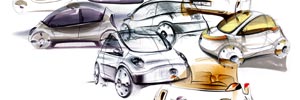
The Acropolis is full of thoughtful design details:
The columns of the Parthenon slope gently inward to correct the perspective when looking up at the temple that would otherwise make them appear to be crooked, leaning outward.
It’s almost too clever to be true.
Picture by Shelby Root

Adaptive Path took to heart a diabetic blogger’s call to action and designed a concept for a new device. Charmr is the result of 9 weeks of research into how to make diabetics’ lives easier. Make sure to follow the links in the post, as they explain the design process in detail.

PSFK has a great description of their first flight on Virgin America:
It was like being eaten by an iPhone and sitting in its belly for an hour.
I’ve always been a fan of Virgin Atlantic — it’s the only airline where the safety brochures look like they were put together by a graphic designer. It appears that they’ve paid the same attention to detail for their new US venture, and I for one can’t wait to try it.

Signal vs. Noise posts about the technology of the $100 laptop.
You can pour water on the keyboard…You can dip the base into a bathtub. You can carry it the rain. It’s more robust than your normal laptop. It doesn’t even have holes in the side of it. If you look at it: dirt, sand, I mean, there’s no place for it to go into the machine.
I got a chance to play with one of these the other day. The hardware is indeed very nice, with a distinctive design and a very solid feel. Unfortunately the software is horribly unintuitive. Maybe it’s still in development, maybe I didn’t spend enough time with it, or maybe I’m just too used to regular interface paradigms. My guess is that it’s a consequence of trying to reinvent the wheel, in the process disregarding decades of accumulated user experience knowledge.
I’ve posted about the $100 laptop before.

Surowiecki on feature creep:
The fact that buyers want bells and whistles but users want something clear and simple creates a peculiar problem for companies. A product that doesn’t have enough features may fail to catch our eye in the store. [...] But a product with too many features is likely to annoy consumers and generate bad word of mouth, as BMW’s original iDrive system did.

The flow/state blog recently had a good series of posts on improving the new user experience on websites: hurdles at the entrance to a site, easing visitors in with anonymous accounts and slickest trial-to-signup yet. Well worth reading!

Driving a manual on the steep hills of San Francisco, I find Uros Pavasovic’s Fiat Scratch particularly appealing:
The Fiat Scratch comes pre-equipped with scratches and quirky lights that vaguely resemble freckles. The aim is to make drivers less protective of their cars and more able to lighten up and behave with tolerance on the road.
A concept design for a competition, the Fiat Scratch comes with a “scratch-happy” bumper that is explicitly designed to be more beautiful as it gets dented and nicked. You can find Uros’ competition entry at the Michelin site.
Two related concepts:
- Wabi-Sabi, the Japanese philosophy that embraces a beauty of things imperfect, impermanent, and incomplete. (more)
- Beausage, the beauty that comes with using something.

Another example of retrostalgia from Frog Design’s Samantha Holmes in this wonderful essay about her “love affair with the record player”.
At first, I was fascinated by the odd tension this might pose: the possibility of experiencing a pang of nostalgia for a past that never belonged to me – the establishment of a new period of time, outside the bounds of either a relived past or a fully embraced present.
Also check out the great picture by Bashed

Album art is perhaps the greatest casualty of the digital music revolution. Nowadays, a CD bought is quickly ripped and stuffed in a closet, or perhaps hung on the wall (as an aside, I really want some of those).
And yet, as Adrian Shaughnessy remarks in his excellent piece about the future of album art:
There is an undeniable sense of completeness when music comes with handsome packaging and engaging graphical material.
Luckily, there are also promising signs that alternatives will emerge in the digital world. Apple’s CoverFlow technology, which they acquired from a shareware developer, brings back some warmth to your iTunes library, and the iPhone has it too (scroll to the bottom). The labels are apparently interested as well, though I’m worried that they’re going to come up with something horribly kludgy. There’s something nice about the constraint of an album cover.
However, I’m most excited by physical representations of digital album art. David from Ironic Sans suggests a Digital Jewelbox, basically an LCD screen that displays the artwork from the currently playing song and acts as a remote control.
My all time favorite is Michael Kennedy’s i-Deck prototype. I love the retro-gramophone look, and the way the album art is displayed on the “cd”. The i-Deck has a physical charm that is impossible to match with pure software, and I would pay a lot to have one of these in my living room.



The MIT Technology Review asked a bunch of designers to talk about objects that influenced them, objects of desire. Maybe it’s retrostalgia (new word: nostalgia for something I wasn’t alive for), but polaroid and the walkman really struck a chord in me. Maybe it’s the leather and the clever opening mechanism, maybe it’s the bold colors and simple shape, but there’s just something intensely satisfying about them.











